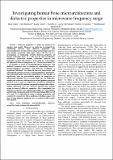| dc.contributor.author | Amin, Bilal | |
| dc.contributor.author | Shahzad, Atif | |
| dc.contributor.author | Farina, Laura | |
| dc.contributor.author | Parle, Eoin | |
| dc.contributor.author | McNamara, Laoise | |
| dc.contributor.author | O'Halloran, Martin | |
| dc.contributor.author | Elahi, Muhammad Adnan | |
| dc.date.accessioned | 2021-03-25T08:34:16Z | |
| dc.date.available | 2021-03-25T08:34:16Z | |
| dc.date.issued | 2019-03-31 | |
| dc.identifier.citation | Amin, Bilal, Shahzad, Atif, Farina, Laura, Parle, Eoin, McNamara, Laoise, O'Halloran, Martin, & Elahi, Muhammad Adnan. (2019). Investigating human bone microarchitecture and dielectric properties in microwave frequency range. Paper presented at the 13th European Conference on Antennas and Propagation (EUCAP), Krakow, Poland, 31 March-05 April. | en_IE |
| dc.identifier.uri | http://hdl.handle.net/10379/16634 | |
| dc.description.abstract | Dielectric properties of bones are proposed to monitor bone quality. However, no study has investigated the relationship between bone dielectric properties and microarchitecture of bone, which is of paramount importance for bone quality assessment. This paper reports the first in-vitro investigation of relationship between dielectric properties of human trabecular bone (n = 45) and its microarchitecture parameters (trabecular number, trabecular thickness and trabecular spacing). The objective of the study was to investigate the difference between osteoporotic (n = 23) and osteoarthritis (n = 22) patients in terms of microarchitectural parameters and dielectric properties and to examine any relationship between microarchitectural parameters and dielectric properties. A significant difference was observed between osteoporotic and osteoarthritis patients in terms of microarchitecture parameters. The trabecular number and trabecular thickness were found to be significantly high for osteoarthritis patients in comparison to osteoporotic patients. The percentage difference for trabecular number and trabecular thickness between both patients group was found to be 27% and 31% respectively. Trabecular spacing was lower in osteoarthritis patients compared to osteoporotic patients. Similar differences were also observed between both patients group in terms of dielectric properties. More importantly, the dielectric properties were significantly higher for osteoarthritis patients than osteoporotic patients with a percentage difference of 42% and 32% at 900 MHz in terms of relative permittivity and conductivity respectively. These preliminary findings support the idea of using dielectric properties to as a method to differentiate bone quality. | en_IE |
| dc.description.sponsorship | The research leading to these results has received funding from
the European Research Council under the European Union's
Horizon 2020 Programme/ ERC Grant Agreement BioElecPro
n. 637780, European Union’s Horizon 2020 research and
innovation Programme under the Marie Skłodowska-Curie
grant agreement No 713690. MicroCT scanning research was
conducted with financial support from the Irish Research
Council Government of Ireland Postdoctoral Fellowship
(GOIPD/2016/493) and Science Foundation Ireland (SFI), and
was co-funded under the European Regional Development fund
under grant number 14/IA/2884. | en_IE |
| dc.format | application/pdf | en_IE |
| dc.language.iso | en | en_IE |
| dc.publisher | Institute of Electrical and Electronics Engineers | en_IE |
| dc.relation.ispartof | 2019 13TH EUROPEAN CONFERENCE ON ANTENNAS AND PROPAGATION (EUCAP) | en |
| dc.rights | Attribution-NonCommercial-NoDerivs 3.0 Ireland | |
| dc.rights.uri | https://creativecommons.org/licenses/by-nc-nd/3.0/ie/ | |
| dc.subject | TRABECULAR BONE | en_IE |
| dc.subject | trabecular microarchitecture | en_IE |
| dc.subject | dielectric properties | en_IE |
| dc.subject | bones | en_IE |
| dc.subject | osteoporotic | en_IE |
| dc.subject | osteoarthritis | en_IE |
| dc.title | Investigating human bone microarchitecture and dielectric properties in microwave frequency range | en_IE |
| dc.type | Conference Paper | en_IE |
| dc.date.updated | 2021-03-19T10:49:57Z | |
| dc.local.publishedsource | https://ieeexplore.ieee.org/abstract/document/8739269 | en_IE |
| dc.description.peer-reviewed | peer-reviewed | |
| dc.contributor.funder | H2020 European Research Council | en_IE |
| dc.contributor.funder | Horizon 2020 Framework Programme | en_IE |
| dc.contributor.funder | Irish Research Council | en_IE |
| dc.contributor.funder | Science Foundation Ireland | en_IE |
| dc.contributor.funder | European Regional Development Fund | en_IE |
| dc.internal.rssid | 17429471 | |
| dc.local.contact | Martin O'Halloran, School Of E&I/School Of Medicine, Nui Galway. 5072 Email: martin.ohalloran@nuigalway.ie | |
| dc.local.copyrightchecked | Yes | |
| dc.local.version | ACCEPTED | |
| dcterms.project | info:eu-repo/grantAgreement/EC/H2020::ERC::ERC-STG/637780/EU/Frontier Research on the Dielectric Properties of Biological Tissue/BIOELECPRO | en_IE |
| dcterms.project | info:eu-repo/grantAgreement/EC/H2020::MSCA-COFUND-FP/713690/EU/Career Development and Mobility Fellowships in Medical Device Research and Development: A CÚRAM Industry-Academia Training Initiative./MedTrain | en_IE |
| nui.item.downloads | 36 | |


